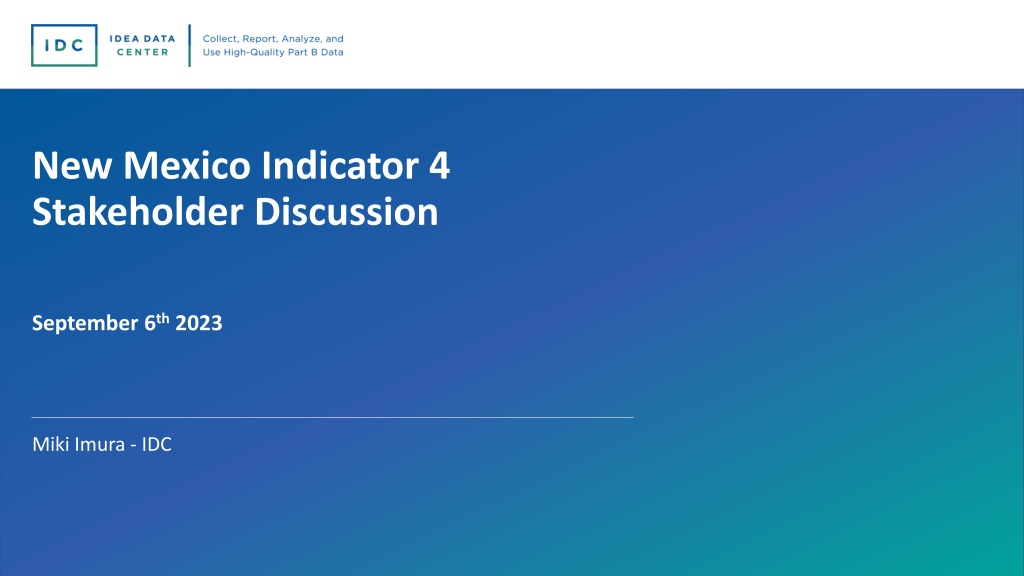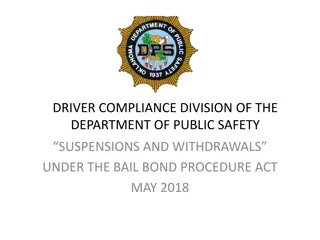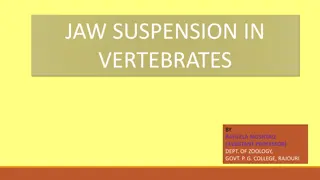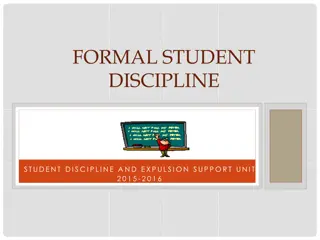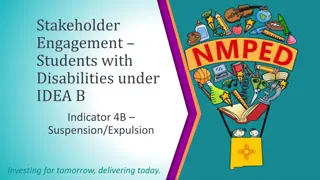Discussion on New Mexico's Special Education Suspension/Expulsion Policies
Stakeholders, including Miki Imura from IDC, gather to discuss New Mexico's policies concerning long-term out-of-school suspensions/expulsions of students with disabilities. Key topics include suspension/expulsion rates among students with disabilities, monitoring of suspension/expulsion usage, equity in academic outcomes, and the importance of the State Performance Plan/Annual Performance Report (SPP/APR) in special education accountability. Imura introduces the IDC's role in supporting states with special education data and policies.
Download Presentation

Please find below an Image/Link to download the presentation.
The content on the website is provided AS IS for your information and personal use only. It may not be sold, licensed, or shared on other websites without obtaining consent from the author. Download presentation by click this link. If you encounter any issues during the download, it is possible that the publisher has removed the file from their server.
E N D
Presentation Transcript
New Mexico Indicator 4 Stakeholder Discussion September 6th2023 Miki Imura - IDC
Do you ever think? I hope students of a particular racial group aren t suspended/expelled more than others! What is NM s suspension/expulsion rates among students with disabilities? What is NM s Special Education Division doing to monitor approproiate usage of suspensions/expulsions for students with disabilities? Are students with disabilities suspended/expelled at a comparable rate across the sate? 3
We are here to discuss NMs policies surrounding the long-term out-of-school suspensions/expulsions of students with disabilities
Why does long-term suspensions/expulsions of student with disabilities matter? >10 days = manifestation determination More time in the classroom = better academic outcomes It s about equity! 5
Let me introduce myself Miki Imura Former special ed data analyst for the CO Dept of Ed Consultant at the IDEA Data Center (IDC) Office of Special Education Programs at the U.S. Ed funds centers that consult with States IDC specializes in special education data and policies Our service is free! :D 6
What is State Performance Plan / Annual Performance Report (SPP/APR)?
SPP/APR is one of these education reports all states are required to submit to the Secretary of Education every year. Education Data Reporting Overview: Education Data / Reports Accountability & Funding U.S. Secretary of Education States and Territories
SPP/APR All states and U.S. territories must submit annually on Feb 1st. Report how states administer special education to students with IEPs. Divided into 17 indicators (next slide). States must set 6-year targets for each indicator and report how well they did against the target every year. 9
Results Indicators Compliance Indicators SPP/APR Indicators 9. Disproportionate Representation in Special Education 1. 2. 3. Graduation Dropout Participation and Proficiency in State Assessments Suspension/Expulsion LRE Placement Early Childhood Settings Preschool Outcomes Parent Involvement 10. Disproportionate Representation in Specific Disability Categories 11. Timely Initial Evaluation 12. Timely Part C to B Transition 4. 5. 6. 7. 8. 13. Secondary Transition IEPs 14. Post School Outcomes 15. Hearing Requests Resolved 16. Mediation Agreements 17. State Systemic Improvement Plan 10
What Is Indicator 4? Divided into 4A and 4B In both, states report the percentage of LEAs that have a significant discrepancy, as defined by the state, in the rate of out-of-school suspensions and expulsions greater than 10 days in a school year 12
What Is Indicator 4? Important factors about Indicator 4 Out-of-school suspensions/expulsions Include students with IEPs whose out-of-school suspensions/expulsions cumulate more than 10 days in a school year If district s rate is significantly discrepant from the state s rate, the district s policy, procedure, and practices must be reviewed Indicator 4 is about extreme discipline It makes states review the discipline practices of districts that use this extreme discipline practices at a higher rate. 13
What Is Indicator 4A? State vs. LEA Comparison 4.0% Compare the 10-day out-of-school suspension/expulsion rate of students with IEPs between State and LEAs State sets a threshold of significance LEA that exceeds the threshold has a significant discrepancy The LEA s removal rate is significantly discrepant from the state rate. The LEA deemed significantly discrepant undergoes a review of policy, practice, and procedure Sig 3.5% discrepant LEA14 3.0% Threshold = state rate x3 (3%) Out-Of-School Removal Rate 2.5% 2.0% 1.5% State 1.0% 0.5% 0.0% 0 20 LEAs 14
What Is Indicator 4B? State vs. LEA by Race Comparison 3.5% Sig Compare the 10-day out-of-school suspension/expulsion rate of students with IEPs between State and LEAs by race/ethnicity State sets a threshold of significance LEA that exceeds the threshold with one or more racial groups has a significant discrepancy The LEA s race-specific removal rate is significantly discrepant from the state rate. LEA deemed significantly discrepant undergoes a review of policy, practice, and procedure LEA1 Native American Discrepant 3.0% Threshold = state rate x3 (3%) 2.5% Out-Of-School Removal Rate LEA1 Black/African American 2.0% LEA1 Two or More Races 1.5% LEA1 Hispanic/Latino 1.0% State All Race LEA1 Pacific Islanders LEA1 White 0.5% LEA1 Asian 0.0% 0 1 2 3 4 5 6 7 8 9 LEA 1 15
What Is Indicator 4? Minimum cell/N size Cell size A state can set a minimum cell and/or N size of any size it wants. 4 students suspended/expelled If a district doesn t meet the minimum cell and/or N size, the district is excluded from Indicator 4. N size 8 students enrolled Suspension/Expulsion rate = 0.5 16
What Is Indicator 4? - Recap 4A = State rate vs. LEA rate 4B = State rate vs. LEA race-specific rate If policy is noncompliant, correction of noncompliance must happen Calculate the suspension/expulsion rate LEA s rate exceeds the threshold of significance Review of policy, procedure, and practice LEAs meet the minimum cell/N size State can set the threshold in any way If LEA doesn t have enough students with disabilities to meet the state-set minimum cell/N size, the LEA is excluded from further analyses 17
4A Minimum cell size of 10 Districts must have at least 10 students with disabilities who are suspended/expelled out-of-school for more than 10 days Threshold of significance: +1% of the state rate NM s Current Methodology Cell size 4 students suspended/expelled 4B Minimum cells size of 10 District must have at least 10 students with disabilities of a particular race with disabilities who are suspended/expelled out-of-school for more than 10 days Threshold of significance: +1% of the state rate (the same as 4A) N size 8 students enrolled Suspension/Expulsion rate = 0.5 These are VERY hard to meet. 19
Current Methodology # of LEAs with at least 10 students with OSS > 10days State Rate Threshold (+1% of state rate) # of LEAs that exceeded the threshold Year 2019-20 2020-21 2021-22 total# of LEAs 146 147 148 5 0 6 0.25% 0.01% 0.36% 1.25% 1.01% 1.36% 1 0 2 4A 2019-20 2020-21 2021-22 146 147 148 5 0 5 0.25% 0.01% 0.36% 1.25% 1.01% 1.36% 1 0 1 4B 20
Current Methodology # of LEAs with at least 10 students with OSS > 10days State Rate Threshold (+1% of state rate) # of LEAs that exceeded the threshold Year 2019-20 2020-21 2021-22 total# of LEAs 146 147 148 5 0 6 0.25% 0.01% 0.36% 1.25% 1.01% 1.36% 1 0 2 4A 2019-20 2020-21 2021-22 146 147 148 5 0 5 0.25% 0.01% 0.36% 1.25% 1.01% 1.36% 1 0 1 4B 1 or 2 LEAs policies are reviewed 95-100% of LEAs are excluded 21
Current Methodology Problems <5% of LEAs meet the minimum cell size rule Only 1-2 LEAs policies are reviewed annually The Office of Special Education Programs (OSEP) at the U.S. Ed finds it reasonable when 90% of LEAs meet the minimum cell and/or N size The threshold of significance is set at +1% of the state rate Ranges between 3.8 times of the state rate 135 times of the state rate OSEP finds it reasonable when the threshold is 3.0 times of the state rate 22
4A No minimum cell size Minimum N size of 10 Districts must have at least 10 students with disabilities enrolled Threshold of significance: 3 times of the state rate Proposing Methodology Cell size 4 students suspended/expelled 4B No minimum cell size Minimum N size of 10 District must have at least 10 students with disabilities of a particular race enrolled Threshold of significance: 3 times of the state rate (same as 4A) N size 8 students enrolled Suspension/Expulsion rate = 0.5 24
Proposing Methodology # of LEAs that exceeded the threshold # of LEAs with SPED enrollment > 10 Year 2019-20 2020-21 2021-22 total# of LEAs State Rate Threshold 146 147 148 136 136 139 0.25% 0.01% 0.36% 0.74% 0.02% 1.07% 10 4 12 4A 2019-20 2020-21 2021-22 146 147 148 127 129 127 0.25% 0.01% 0.36% 0.74% 0.02% 1.07% 17 4 17 4B 25
Proposing Methodology Threshold (x3 of state rate) # of LEAs that exceeded the threshold # of LEAs with SPED enrollment > 10 Year 2019-20 2020-21 2021-22 total# of LEAs State Rate 146 147 148 136 136 139 0.25% 0.01% 0.36% 0.74% 0.02% 1.07% 10 4 12 4A 2019-20 2020-21 2021-22 146 147 148 127 129 127 0.25% 0.01% 0.36% 0.74% 0.02% 1.07% 15 4 17 4B 86-94% of LEAs are included None of the excluded LEAs have any OSS>10 -> NM might not need a minimum N size 26
# of LEAs with reviews for policy, procedure, and practices Most LEAs exceeding the threshold with 4A also exceed with 4B Overlapping LEAs between 4A and 4B # of LEAs needing to be reviewed 4A 4B NM ends up reviewing discipline policies of 11% of LEAs annually with the proposing methodology. 2019-20 10 15 9 16 2020-21 4 4 4 4 2021-22 12 17 12 17 27
Proposing Methodology Problems it ll solve Most LEAs will meet the minimum N size rule 11% of LEAs policies will be reviewed annually The threshold of significance will be set at x3 of the state rate No more OSEP inquiry Remaining Problems NM must review about 11% of LEAs policies annually -> high monitoring burden many LEAs exceeded the threshold with only 1 student with OSS>10 days 28
For More Information Visit the IDC website http://ideadata.org/ Follow us on Twitter https://twitter.com/ideadatacenter Follow us on LinkedIn http://www.linkedin.com/company/idea-data-center 30
The contents of this presentation were developed under a grant from the U.S. Department of Education, #H373Y190001. However, the contents do not necessarily represent the policy of the U.S. Department of Education, and you should not assume endorsement by the federal government. Project Officer: Richelle Davis 31
